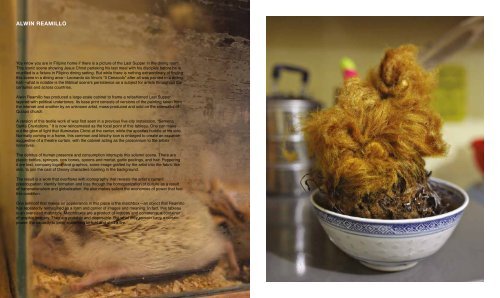You also want an ePaper? Increase the reach of your titles
YUMPU automatically turns print PDFs into web optimized ePapers that Google loves.
ALWIN REAMILLO<br />
You know you are in Filipino home if there is a picture of the Last Supper in the dining room.<br />
This iconic scene showing Jesus Christ partaking his last meal with his disciples before he is<br />
crucified is a fixture in Filipino dining setting. But while there is nothing extraordinary of finding<br />
this scene in a dining area—Leonardo da Vinci’s “Il Cenacolo” after all was painted in a dining<br />
hall—what is notable is the Biblical scene’s persistence as a subject for artists throughout the<br />
centuries and across countries.<br />
Alwin Reamillo has produced a large-scale cabinet to frame a refashioned Last Supper<br />
layered with political undertones. Its base print consists of versions of the painting taken from<br />
the internet and another by an unknown artist, mass-produced and sold on the sidewalks of<br />
Quiapo church.<br />
A version of this textile work of was first seen in a previous five-city installation, “Semena<br />
Santa Cruxtations.” It is now reincarnated as the focal point of this tableau. One can make<br />
out the glow of light that illuminates Christ at the center, while the apostles huddle at his side.<br />
Normally coming in a frame, this common and kitschy icon is enlarged to create an expanse<br />
suggestive of a theatre curtain, with the cabinet acting as the proscenium to the artists’<br />
narratives.<br />
The detritus of human presence and consumption interrupts this solemn scene. There are<br />
plastic bottles, syringes, cow bones, spoons and mortar, garlic peelings, and hair. Peppering<br />
it are text, company logos, and graphics, some image grafted by the artist into the fabric like<br />
skin, to join the cast of Disney characters looming in the background.<br />
The result is a work that overflows with iconography that reveals the artist’s current<br />
preoccupation: identity formation and loss through the homogenization of culture as a result<br />
of transnationalism and globalization. He also makes salient the economies of power that fuel<br />
this condition.<br />
One leitmotif that makes an appearance in this piece is the matchbox—an object that Reamillo<br />
has repeatedly reimagined as a form and carrier of images and meaning. In fact, this tableau<br />
is an oversized matchbox. Matchboxes are a product of industry and commerce, a container<br />
of graphic imagery. They are portable and disposable. But what they contain carry a certain<br />
power: the capacity to bring something to light and start a fire.


